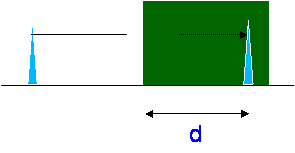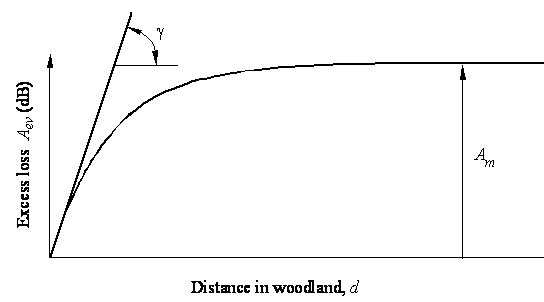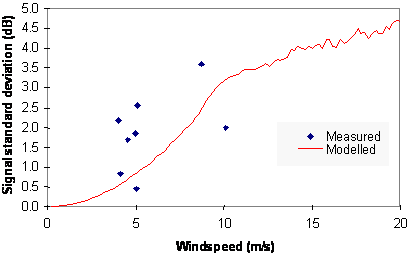

The Fundementals
Introduction Maxwell's equations Plane waves Free space loss Gas Loss Refraction Diffraction Reflections Troposcatter Rain effects Vegetation Statistics Link budgets Noise Multipath Measurements Models
Clutter
and Vegetation
"Clutter" means things spoiling the view that are not part of the
terrain (including vegetation). Vegetation mainly refers to trees and large
bushes that also get in the way of the radio path. Clutter causes loss as
it is usually made of “lossy” materials. Buildings are often thought
to be completely opaque, this is incorrect, signals do penetrate buildings
especially if there are many windows in an open plan design or if the walls
are made of wood. Tree branches and leaves cause loss and scatter EM waves
passing through them, resulting in a strong multipath component which varies
with movement of the leaves and branches in the wind. Trees often have more
foliage in the summer than the winter and this leads to seasonal variability
in their effect on radiowaves.
There is no such thing as a typical tree but here are some examples of the
loss in dB/m experienced while moving into a woodland:


This is a little misleading as it depends very much on the particular woodland in question. Looking at it more analytically, higher frequency waves propagate little into the vegetation, but diffract around it both horizontally and vertically reflect from the ground.

A traveling wave propagates over the top of the
vegetation by Radiative transfer. This is a forward scattering mode through
the canopy, a bit like rain scatter. The scattering function depends strongly
on the number of leaves, the leaf shape, how much water each leaf contains.

The result is an initial rapid signal drop with loss that starts to tail off
as you go further into the wood. Beyond a certain depth into the wood, the
loss does not increase much.

The maths is difficult, below is is an example of
one of the RET theory equations, which is why we will not go into this in
any detail in this stage.
While the scattering loss would be difficult to work out by hand, it is relatively easy to implement as a computer programme. The input parameters required depend on the tree type. A good set of these along with a full explanation of the model is available from the latest version of the ITU-R recommendation P.833.
Dynamic effects
As trees move in the wind, the signal received through vegetation which contains many multipath components varies rapidly with time. An example of a measured standard deviation of signal level against wind speed at 38GHz was measured as part of the EU 5th Framework Embrace project and are now incorporated in ITU-R recommendation P.1410.


© Mike Willis May 5th, 2007